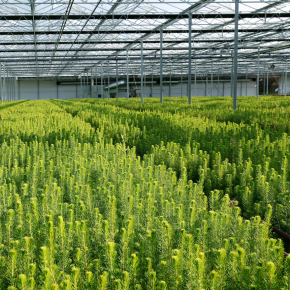
Södra discusses protecting the environment and meeting timber demand
 Careful, quality forest management can both protect the environment and help meet an ever-growing demand for timber from the building trade, says Glenn Faxhag-Raymond, Forest Consultant at Södra. Södra is one of Europe’s largest suppliers of high-quality, sustainable timber.
Careful, quality forest management can both protect the environment and help meet an ever-growing demand for timber from the building trade, says Glenn Faxhag-Raymond, Forest Consultant at Södra. Södra is one of Europe’s largest suppliers of high-quality, sustainable timber.
The right trees in the right place
Much like the early development of your children, quality forest management begins at the nursery. At Södra, for example, the basis of our Falkenberg nursery is harnessed from some of the best quality trees in the world. The programme does not and has never used genetic modification in any way, but rather ensures that all desirable traits of selected spruce are transferred to seeds, and then to future trees. This helps produce higher quality trees and ultimately improves the overall quality of the end-product.
The next step is planting. Firstly, it’s my job to speak with and educate forest-owners as to the importance of planting the right trees in the right place. We do this by looking at what trees are already there and what other wildlife is flourishing. Which mosses are growing; are there blueberries or nettles? Everything that’s going on above the ground gives us a good idea of what’s happening beneath the surface and helps us to decide which species should be planted. There also can’t just be a whole estate of spruce, for instance. There has to be other tree species mixed in – such as pine or broad-leaved trees – to attract different birds and insects and generally better enrich the biodiversity of the forest.
We then have to get the planting right. If, for instance, you plant a tree and it leans, you’ll likely get a little crook which could ultimately impact the quality of the end-product. Then it’s a case of letting the tree grow and closely monitoring and managing it – especially for the first 10-15 years of its life.
Thinning: it’s nothing to worry about!
People sometimes shirk at the thought of thinning areas of forest but it’s essential to the better management and continued development of healthy forests. There are two types of thinning: manual thinning, which occurs in the first 10-15 years of a tree’s life, and machine thinning, which occurs once the trees are 15-plus years’ old.
Thinning removes slower-growing or defective trees, thereby providing more space and sunlight for the remaining trees to flourish. If, for example, trees grow too close to one another they won’t receive as much sunlight which means they will lose some of their greenery. This can lead to branches dying
and trees getting smaller and smaller which is not conducive to high-quality, strong timber. The improved supply of soil nutrients, water and light results in bigger, healthier trees and better-quality timber.
Protecting the forest (and the people and animals that depend on it)
We at Södra are fortunate to have inherited the vast amounts of healthy forests that we enjoy today. What we’re harvesting now is what our ancestors looked after and left behind, which is why we not only owe a debt of gratitude but have an obligation to make sure our forests continue to flourish for the next 100 years (and beyond!).
All activity should be geared toward the continued health and upkeep of the forest, from protecting the forest floor from machinery by laying errant, loose branches and foliage, to mapping a safe route in and out of the forest so that machinery doesn’t get stuck or sink. Never, at any point in the timber-growing process should chemicals be used. Of course, this includes the nurturing of saplings and continued upkeep of the forest, but it also includes what’s put into machinery. Any oil put into forest machinery should be classified to a certain standard and should have thorough documentation which clearly shows where it has come from.
Incidentally, these are all factors that need to be covered in order to achieve PEFC and FSC certification, which is why we don’t just check our own work. External, independent companies should regularly and thoroughly check working conditions and forest management processes.
Forest consultants also have a responsibility to teach forest-owners about responsible game management. Whether that be elks, deer or bore, each species effects the forest in different ways and could tilt the forest’s ecological balance and impact how trees grow. Responsible game management helps ensure that the forest remains healthy and that its many varied species continue to thrive.
The tech revolution
The technological revolution has changed everyone’s lives – not least forest-owners and consultants! Drones help us see just how much forest our forest-owners have and where their boundaries are. They also save so much time, allowing us to quickly identify areas of storm damage and accurately map the forest. We can identify small marshes and water holes, trees that we want to grow and protect, where we need to put the timber once it’s harvested and whether the roads are suitable for heavy machinery and trucks.
This footage can also be incorporated into a smart device and overlaid onto a forest plan showing (amongst other things) how much wood is below, the percentage of different species of trees, how old the wood is and what the suggested plans are for the future.
Overcoming challenges
The climate is a constant, ever-evolving challenge. Forest fires and/or the risk of forest fires can be problematic, as are droughts, which is why it’s so important to look at water table levels and what’s going on beneath the surface to ensure you plant the right species in the right place.
With warmer weather comes the proliferation of bark beetle: a common and potentially devastating pest which tunnel under bark, cutting off the supply of food and water the tree needs to survive. They can kill a tree in as little as two to four weeks.
At Södra, we combat them by strictly maintaining best practice forest management, including ensuring that the number of trees growing is appropriate for the acreage and carrying out responsible, regular thinning. We never use any form of chemical deterrent but instead lay traps and attract bark beetle with endorphins typically released by a tree in distress. This helps us to not only exterminate the bark beetle but learn more about their activity so that we may better plan ahead.
Quality forest management: we owe it to future generations
Timber’s sustainability credentials, durability and flexibility (coupled with the need to meet environmental needs) means its demand will inevitably continue to increase. This is a good thing, of course, and makes complete sense. After all, timber sequesters harmful carbon dioxide from the atmosphere and helps reduce the overall carbon footprint of a building project. But this counts for little unless the timber being used has come from sustainable, responsibly managed forests, so be sure of the quality and provenance of the timber you buy and sell. Our future depends on it.
Address: Södra Wood Ltd, Unit 18/19, Cirencester Office Park, Tetbury Road, Cirencester GL7 6JJ
Phone: +44 (0)1285 646000
Fax: +44 (0)1285 646020
Email: ukinfo@sodra.com
Visit Supplier's page
Latest news

28th March 2025
Ideal Heating Commercial announces 10-year warranty on Evomax 2 boiler
Evomax 2, the UK’s number one selling commercial wall-mounted boiler from Ideal Heating Commercial, is now available with a 10-year warranty.
Posted in Articles, Building Industry News, Building Products & Structures, Building Regulations & Accreditations, Building Services, Facility Management & Building Services, Heating Systems, Controls and Management, Heating, Ventilation and Air Conditioning - HVAC, Innovations & New Products, Pipes, Pipes & Fittings, Plumbing, Retrofit & Renovation, Sustainability & Energy Efficiency, Videos
28th March 2025
FLIR Si1-LD Acoustic Imaging Camera for Compressed Air Leak Detection
FLIR, a Teledyne Technologies company, introduces the Si1-LD, an industrial acoustic imaging camera that brings faster and more accurate compressed air leak detection to those operating on a modest condition monitoring budget.
Posted in Acoustics, Noise & Vibration Control, Articles, Building Industry News, Building Products & Structures, Building Services, Facility Management & Building Services, Information Technology, Innovations & New Products, Retrofit & Renovation, Sustainability & Energy Efficiency, Thermal Imaging and Monitors
28th March 2025
LIFTEX 2025 Seminar programme announced
Registration has opened for LIFTEX 2025. Now in its 37th year, LIFTEX 2025 is the UK’s only dedicated exhibition for the lift, escalator and access industry and takes place only once every three years.
Posted in Access Control & Door Entry Systems, Accessibility, Articles, Building Industry Events, Building Industry News, Building Products & Structures, Building Regulations & Accreditations, Building Services, Exhibitions and Conferences, Facility Management & Building Services, Health & Safety, Retrofit & Renovation, Security and Fire Protection, Seminars
28th March 2025
MCRMA welcomes ArcelorMittal UK to membership
A UK division of the global steelmaking business ArcelorMittal has become the latest new member of the MCRMA, the industry association representing the metal building envelope sector.
Posted in Articles, Building Associations & Institutes, Building Industry News, Building Products & Structures, Building Systems, Cladding, Facades, Posts, Restoration & Refurbishment, Retrofit & Renovation, Roofs, Steel and Structural Frames, Walls
 Sign up:
Sign up: